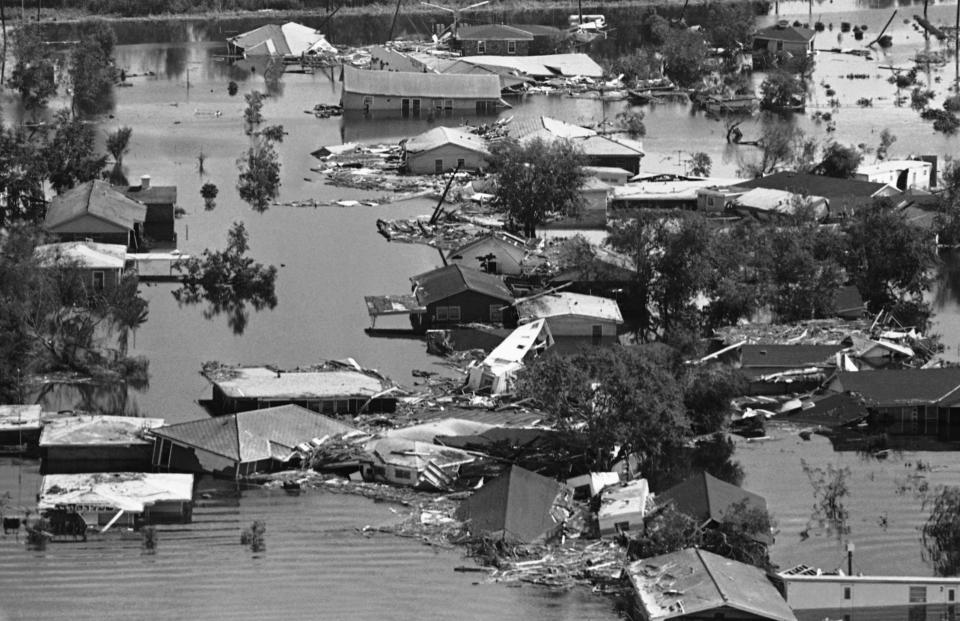Category 5 hurricanes are rare. How does Ian compare to the worst storms?
Hurricane Ian was intensifying Wednesday, with winds topping 155 mph — just 2 mph shy of becoming a Category 5 storm.
That status, which forecasters consider catastrophic, is actually rare for the United States: Only four Category 5 hurricanes have made landfall since 1851.
Here's what you need to know.
How are hurricanes ranked? The Saffir-Simpson Hurricane Wind Scale ranks the storms on a 1 to 5 rating based on its maximum sustained wind speed, according to the National Hurricane Center. The scale does not take other factors — like storm surge, rainfall or flooding — into account.
What's considered a major hurricane? Storms rated Category 3 and higher are considered "major hurricanes." A hurricane is classified in Category 5 once winds reach 157 mph and above. At this level, "catastrophic damage will occur," according to the National Hurricane Center, including a high percentage of homes destroyed, trees and power lines downed, and power outages lasting for weeks to months.
How storms are measured: A drop in pressure, measured in millibars, often indicates the approach of a storm. Typically, the farther barometric pressure drops, the stronger the storm will be.
How common are Category 5 storms? Since 1924, only 37 hurricanes have hit Category 5 status at least briefly in the Atlantic Basin, according to the National Hurricane Center. Only four Category 5 hurricanes have reached the U.S., with the most recent being Hurricane Michael in 2018.
How does Katrina compare? Hurricane Katrina in August 2005 remains as one of the most devastating storms of all time, but it only reached Category 5 status temporarily, according to the National Weather Service. The hurricane made landfall in southeast Florida as a Category 1, intensified into a Category 5 in the Gulf of Mexico, then weakened to Category 3 before hitting the northern Gulf Coast.
LIVE UPDATES: Ian nears Category 5 status as it nears Florida landfall
HURRICANE TRACKER: Where is Ian headed next?
Here's a breakdown of each of these Category 5 hurricanes, in order of intensity, according to the National Hurricane Center and USA TODAY records:
Labor Day Hurricane
Date: September 1935
Where: The Florida Keys
Landfall wind measurements: 185 mph
Landfall pressure measurements: Estimated at 892 millibars, which makes the Labor Day Hurricane the most intense on record in the U.S.
Deaths: Over 400 people
Damage: An estimated $6 million of damage at the time, which would be about $130 million today taking in consideration inflation.

Hurricane Camille
Date: August 1969
Where: Mississippi, Tennessee, Kentucky, West Virginia, Virginia
Landfall wind measurements: 175 mph
Landfall pressure measurements: 900 millibars
Rainfall: About 10 inches of consistent rain drenched the Gulf Coast while the Virginias saw a burst of 12 to 20 inches of rain, causing catastrophic flooding.
Deaths: 256 people in the U.S. and three people in Cuba
Damage: An estimated $1.42 billion of damage at the time, which would be about $11.5 billion today
HURRICANE STRENGTH RANKINGS: Here are the top strongest hurricanes

Hurricane Andrew
Date: August 1992
Where: Southern Florida, Louisiana
Landfall wind measurements: 165 mph
Landfall pressure measurements: 922 millibars
Deaths: 23 people in the U.S. and three in the Bahamas.
Damage: An estimated $26 billion of damage at the time, which would be about $55 billion today. About 49,000 homes were destroyed and 108,000 damaged, according to the National Weather Service.

Hurricane Michael
Date: October 2018
Where: Florida Panhandle and southwest Georgia
Landfall wind measurements: 160 mph
Landfall pressure measurements: 919 millibars
Deaths: 16 people
Damage: An estimated $25 billion of damage at the time.

More Hurricane Ian coverage
What is storm surge? Graphics explain the deadly weather event.
The Jim Cantore effect: What it means when the meteorologist shows up in your city
Evacuations: How to stay safe as Ian approaches Florida's coast
Contributing: Dinah Pulver, USA TODAY
Contact News Now Reporter Christine Fernando at [email protected] or follow her on Twitter at @christinetfern.
This article originally appeared on USA TODAY: Category 5 hurricanes in the US: How Ian compares to worst storms